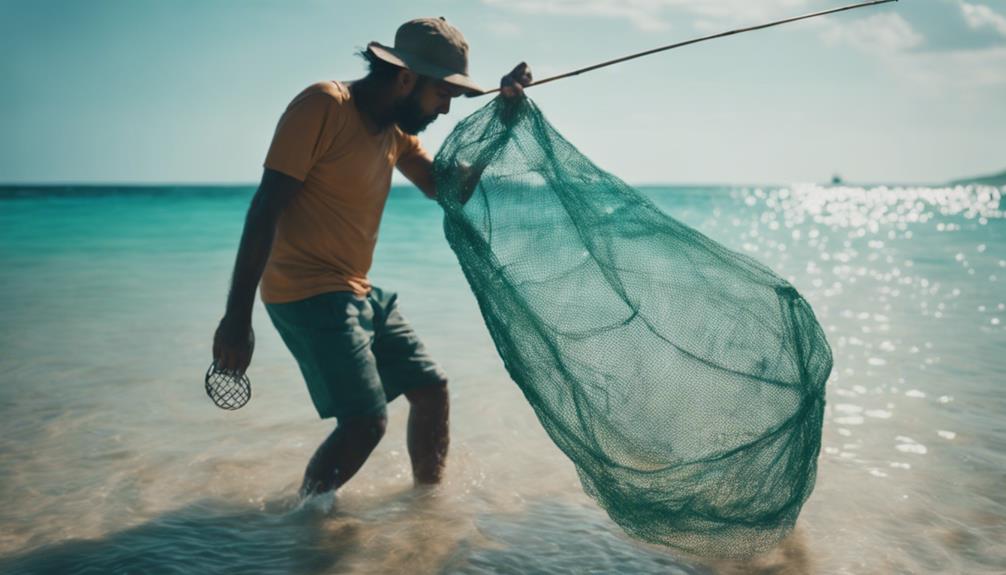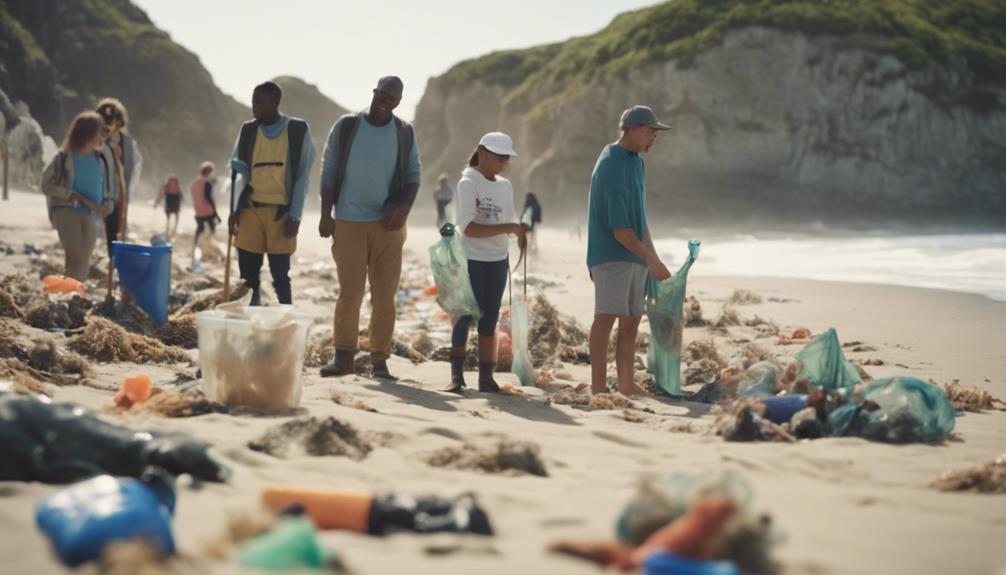Are you aware of the key strategies that can make a positive impact on fish populations? Understanding these practices is essential for anyone concerned about sustainable fishing and marine life conservation.
By implementing these best practices, you can contribute to the preservation of marine biodiversity and the long-term health of our oceans.
Want to know how you can play a role in safeguarding fish populations and marine ecosystems?
Key Takeaways
- Implement sustainable fishing practices to protect marine wildlife and preserve biodiversity.
- Support habitat restoration initiatives like aquatic plant restoration and artificial reef construction.
- Engage in responsible seafood consumption to reduce overfishing and support marine protected areas.
- Promote data-driven research and collaboration for long-term ocean health and sustainable seafood practices.
Sustainable Fishing Practices

To positively impact fish populations, start by adopting sustainable fishing practices that have been proven effective over generations. Indigenous cultures have historically utilized sustainable methods to maintain fish populations, ensuring the health of marine biodiversity.
For instance, the tagbanua people in the Philippines practice selective fishing, which aids in preserving marine ecosystems. Additionally, modern sustainable fishing methods like spearfishing and rod-and-reel fishing play a significant role in protecting marine wildlife.
Habitat Restoration Initiatives

When it comes to habitat restoration initiatives, focusing on aquatic plant restoration, artificial reef construction, and streambank stabilization efforts can greatly benefit fish populations.
By enhancing and creating new habitats, you provide shelter for fish species, increase biodiversity, and promote a healthier ecosystem.
These restoration projects play an important role in supporting sustainable fishing practices and mitigating the negative impacts of overfishing.
Aquatic Plant Restoration
Restoring aquatic plant communities is essential for enhancing fish populations and overall ecosystem health. Aquatic plant restoration projects focus on reviving important habitats for fish, providing shelter, food, and breeding grounds for various species.
By bringing back healthy aquatic plants, biodiversity increases, and ecosystem resilience improves. These plants play an essential role in upholding water quality and oxygen levels necessary for fish survival. Successful restoration initiatives have demonstrated positive effects on fish populations and the overall well-being of the ecosystem.
Ensuring the presence of thriving aquatic plant communities is key to supporting fish populations and maintaining a balanced and sustainable aquatic environment.
Artificial Reef Construction
Reviving aquatic plant communities is essential for enhancing fish populations and ecosystem health; moving to the current subtopic, artificial reef construction, offers another impactful approach to habitat restoration initiatives.
Artificial reef construction involves creating structures like sunken ships or concrete blocks to provide habitats for marine species. These artificial reefs can help restore damaged habitats, increase biodiversity, and support fish populations by attracting juvenile fish, offering shelter, and serving as breeding grounds.
Studies show that artificial reefs play an important role in enhancing fish populations. Additionally, artificial reef projects not only benefit marine ecosystems and fishing communities but also boost local economies through increased tourism and recreational fishing opportunities.
Proper planning and monitoring are crucial for the success of artificial reef projects, ensuring their positive impact on fish populations and habitats.
Streambank Stabilization Efforts
Implementing streambank stabilization efforts is essential for enhancing habitat quality and promoting healthy fish populations in aquatic ecosystems. By restoring and protecting stream and river banks, erosion is prevented, creating a conducive environment for fish.
Planting native vegetation along these banks stabilizes soil, reduces sediment runoff, and provides important shade and shelter for various fish species. Incorporating rock or log structures further diversifies habitats, important for fish breeding, feeding, and finding shelter.
Through these projects, water quality is improved as sedimentation and pollution runoff into aquatic ecosystems decrease. Properly managed streambanks not only support sustainable fisheries but also enhance biodiversity, promoting ecosystem resilience.
Engaging in streambank stabilization is an important aspect of fisheries management to foster thriving fish populations and overall habitat quality.
Controlled Fishing Regulations

When it comes to impacting fish populations positively, remember to contemplate size limits for sustainability, seasonal closures for protection, and quota management for balance.
These regulations play an important role in maintaining healthy fish populations and preventing overfishing. By adhering to these guidelines, you contribute to the conservation efforts and long-term viability of fish populations.
Size Limits for Sustainability
Size limits in fishing regulations play an important role in protecting juvenile fish and maintaining population stability. By implementing size restrictions, sustainable fisheries management is promoted, preventing overexploitation of fish stocks.
These limits make sure that fish have the chance to mature and reproduce before being caught, contributing to the long-term health of populations. Preserving the breeding potential of fish species through size limits helps maintain a balanced ecosystem.
Seasonal Closures for Protection
During critical periods, seasonal closures are essential for protecting fish populations and ensuring sustainable stocks for the future. By limiting fishing activities during breeding and spawning seasons, these closures prevent overfishing and allow fish to reproduce, replenishing their numbers.
Research indicates that implementing seasonal closures has led to significant increases in fish populations and improved biodiversity in managed areas. These controlled fishing regulations play an important role in maintaining healthy ecosystems, supporting marine biodiversity, and promoting long-term sustainability.
Countries worldwide have successfully integrated seasonal closures into their fisheries management strategies, demonstrating their effectiveness in conserving fish populations and habitats. Seasonal closures are an important tool in the conservation toolbox, helping to safeguard fish stocks and preserve marine environments for generations to come.
Quota Management for Balance
Implementing quota management is essential for maintaining a balanced approach to fishing and ensuring sustainable fish populations.
Quota management:
- Sets limits on fish catches to prevent overexploitation.
- Allocates specific quotas to promote responsible harvesting.
- Is based on scientific assessments to maintain ecological balance.
Community Engagement in Conservation

Engaging local communities in conservation efforts enhances awareness and support for sustainable fishing practices.
Involving local communities in conservation programs fosters a sense of ownership and responsibility for protecting fish populations.
Collaborating with community members can lead to innovative solutions for managing and preserving fish stocks effectively.
Educating and empowering communities about the significance of sustainable fishing practices can drive positive changes in behavior and attitudes.
Additionally, building strong relationships with local stakeholders cultivates a shared commitment to safeguarding marine ecosystems and fish habitats.
Monitoring and Research Efforts

Monitoring fish populations is essential for understanding their abundance and distribution trends. Research efforts provide important data on fish demographics, behavior, and health, aiding in effective management decisions. Various methods like tagging, genetic analysis, and underwater surveys are employed in monitoring programs to study fish populations. Research initiatives focus on understanding the impacts of fishing pressure, environmental changes, and habitat loss on fish populations. Continuous monitoring and research efforts play an important role in developing sustainable management strategies for fish populations.
- Tracking trends in abundance and distribution
- Studying fish demographics, behavior, and health
- Understanding impacts of fishing pressure and environmental changes
Responsible Seafood Consumption Campaigns

To make a positive impact on fish populations, consider supporting responsible seafood consumption campaigns that educate consumers on sustainable choices. These campaigns emphasize the importance of opting for seafood from fisheries with MSC certification, guaranteeing sustainable practices are upheld.
By promoting responsible seafood consumption, consumers play a vital role in reducing overfishing and safeguarding marine ecosystems. Understanding the impact of consumer choices on fish populations and the environment is key to making informed decisions.
Engaging in sustainable seafood practices contributes to the long-term health of fish populations and supports ocean sustainability efforts. Support these campaigns to help protect marine life and guarantee a healthier future for our oceans.
Collaboration for Marine Protected Areas

Collaborate with governments, stakeholders, and communities to establish and manage Marine Protected Areas (MPAs) for conservation goals. Effective collaboration in creating and maintaining MPAs is essential for safeguarding marine biodiversity and ensuring sustainable marine resources.
Together, these efforts can combat overfishing, prevent habitat destruction, and mitigate biodiversity loss. By working hand in hand, MPAs aid in the recovery of fish populations, promote biodiversity conservation, and enhance ecosystem resilience.
Data-driven monitoring and research within MPAs play an important role in informing adaptive management strategies, leading to the sustainable use of marine resources. Join forces with various entities to support the establishment and management of MPAs, contributing to the long-term health of our oceans and marine life.
Conclusion
You can make a difference by following these 7 best practices for positively impacting fish populations.
By enhancing data quality, combatting illegal fishing, and promoting sustainable practices, you're helping to safeguard marine biodiversity and guarantee healthy fish populations for the future.
Together, we can work towards responsible fishing practices and the preservation of marine ecosystems.
Make a difference today by implementing these practices in your fishing activities.
👨👩👧👦 Dwight’s a married dad of 4 who loves to cast a line 🎣 into both fresh and salt waters. His heart belongs to his family and the sea. 🌊 #FamilyMan #FishingLife #DadOf4 🐟✨

